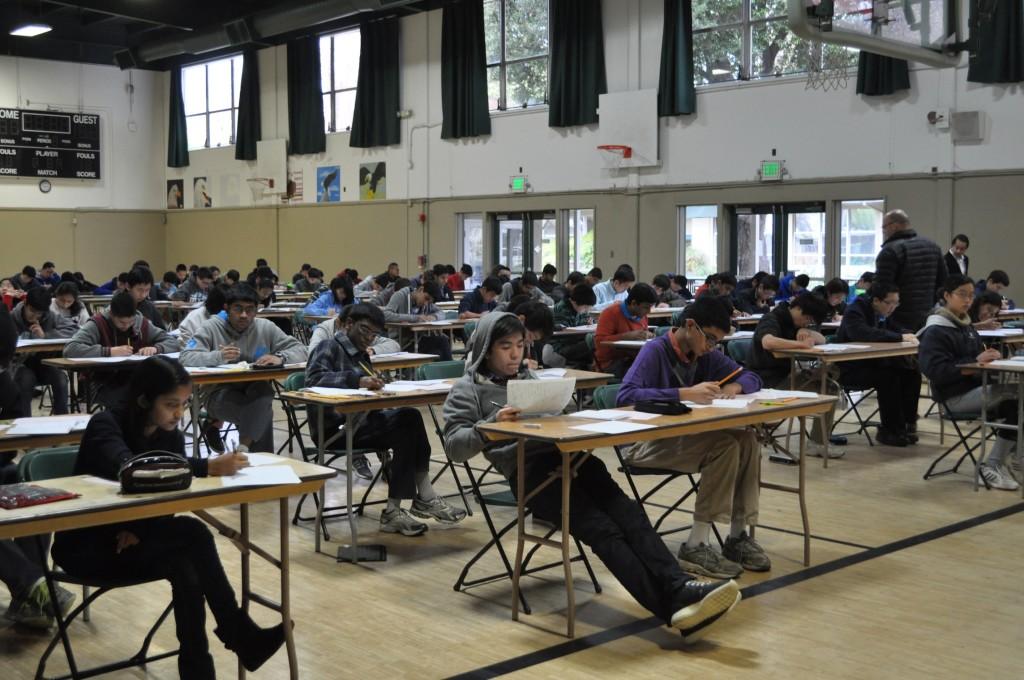Math enthusiasts take AMC 10/12 at the Upper School
Students take the AMC 10 and 12 in the gym. The AMC consists of three main problem types: number theory, geometry, and probability.
One hundred thirty two Upper School students convened in the gymnasium to partake in the American Mathematics Contest 10/12 (AMC 10/12) on Feb. 4 from 8 a.m. to 9:15 a.m.
The AMC 10/12 is a 75-minute long test with 25 questions of varying subjects and difficulty levels. Twelve questions are shared between the level 10 and 12 tests, which are for grades 10 and below and for grades 12 and below respectively, but the others differ based on the mathematical concepts they use—the AMC-10 uses mainly algebraic and geometric concepts, whereas the AMC-12 uses concepts taught up to the precalculus level.
According to the Mathematical Association of America (MAA)’s website, the AMC is designed “to help identify those few students with truly exceptional mathematics talent.”
Mathematics teacher Misael Fisico discussed both preparation and attendance for the contest.
“Attendance keeps on getting bigger…it seems that students that are very much interested are the only ones who are taking the contest,” he said. “[To prepare], students have regular attendance in math competitions, because we do have a number of math contests between August and January. They are in-school competitions, and most of them are meant to prepare you for big-time contests in February.”
For the test itself, many students felt like the AMC was too variable from previous years.
“I thought it was just like any other years. It was typically the same type of problems and wasn’t anything new,” Matthew Huang (11) said. “[Topics included] probability, number theory, algebra, geometry, and combinatorics. My favorite is probably algebra, because it makes the most sense to me, and it’s the most intuitively interesting.”
According to mathematics teacher Bradley Stoll, the AMC mostly consists of three main types of problems, which are number theory, geometry, and probability. These questions serve a large role in showcasing both prowess with numbers and capability for critical thinking.
“I think they’re great problems because they make you bring in lots of different areas and they make you think, much more than I think standard curriculum does. I think they force you to be a little creative at times,” Bradley Stoll, Upper School mathematics teacher, said.
Shannon Hong (10) found some problems challenging.
“All of the questions you can find an answer with logic, but I think the hardest part about the AMC is finding the easiest and correct way of doing it,” she said.
Rishabh Chandra (10) thought that the test was difficult to finish on time.
“There are 25 questions so you have three minutes per problem, and some of the problems need a lot more time than that,” he said.
Rewards including Certificates of Achievement, Certificates of Distinction, Winner Pins, and Honor Roll of Distinction pins are all available for various milestones of achievement on the AMC. The top three students from each school will take a gold, silver, or bronze Certificate for Outstanding Achievement, respectively. Students can also qualify to take the American Invitational Mathematics Examination (AIME) by scoring in the top 5 percent for the AMC-12 and the top 2.5 percent for the AMC-10.
Elisabeth Siegel (12) is the editor-in-chief of the Winged Post. This is her fourth year in Journalism, and she especially loves production nights and...


















![“[Building nerf blasters] became this outlet of creativity for me that hasn't been matched by anything else. The process [of] making a build complete to your desire is such a painstakingly difficult process, but I've had to learn from [the skills needed from] soldering to proper painting. There's so many different options for everything, if you think about it, it exists. The best part is [that] if it doesn't exist, you can build it yourself," Ishaan Parate said.](https://harkeraquila.com/wp-content/uploads/2022/08/DSC_8149-900x604.jpg)




![“When I came into high school, I was ready to be a follower. But DECA was a game changer for me. It helped me overcome my fear of public speaking, and it's played such a major role in who I've become today. To be able to successfully lead a chapter of 150 students, an officer team and be one of the upperclassmen I once really admired is something I'm [really] proud of,” Anvitha Tummala ('21) said.](https://harkeraquila.com/wp-content/uploads/2021/07/Screen-Shot-2021-07-25-at-9.50.05-AM-900x594.png)







![“I think getting up in the morning and having a sense of purpose [is exciting]. I think without a certain amount of drive, life is kind of obsolete and mundane, and I think having that every single day is what makes each day unique and kind of makes life exciting,” Neymika Jain (12) said.](https://harkeraquila.com/wp-content/uploads/2017/06/Screen-Shot-2017-06-03-at-4.54.16-PM.png)








![“My slogan is ‘slow feet, don’t eat, and I’m hungry.’ You need to run fast to get where you are–you aren't going to get those championships if you aren't fast,” Angel Cervantes (12) said. “I want to do well in school on my tests and in track and win championships for my team. I live by that, [and] I can do that anywhere: in the classroom or on the field.”](https://harkeraquila.com/wp-content/uploads/2018/06/DSC5146-900x601.jpg)
![“[Volleyball has] taught me how to fall correctly, and another thing it taught is that you don’t have to be the best at something to be good at it. If you just hit the ball in a smart way, then it still scores points and you’re good at it. You could be a background player and still make a much bigger impact on the team than you would think,” Anya Gert (’20) said.](https://harkeraquila.com/wp-content/uploads/2020/06/AnnaGert_JinTuan_HoHPhotoEdited-600x900.jpeg)

![“I'm not nearly there yet, but [my confidence has] definitely been getting better since I was pretty shy and timid coming into Harker my freshman year. I know that there's a lot of people that are really confident in what they do, and I really admire them. Everyone's so driven and that has really pushed me to kind of try to find my own place in high school and be more confident,” Alyssa Huang (’20) said.](https://harkeraquila.com/wp-content/uploads/2020/06/AlyssaHuang_EmilyChen_HoHPhoto-900x749.jpeg)



